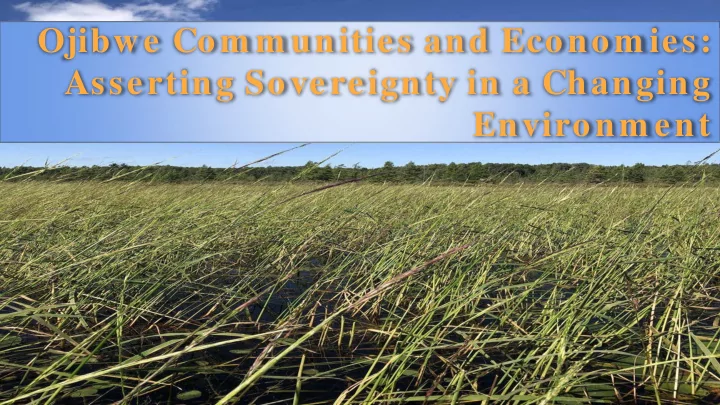

Ojibwe Com m unities and Econom ies: Asserting Sovereignty in a Changing Environm ent
Anishinaabe Nation-Building Period ● Ojibwe/Chippewa Bands allied with the Odawaa and Potawatomi to form the Three Fires Alliance, also referred to as the Anishinaabe Nation, with similar languages and cultural traditions. ● The Anishinaabe came to the upper Great Lakes region more than 400 years ago, with indigenous governance extending over a vast area of lands and waters for several centuries prior to European/American settlement. ● Quality and characteristics of the Anishinaabe nation: ○ Independence of individuals and communities ○ Engagement in international diplomacy & trade ○ When necessary, engaged in warfare and skilled both technically and strategically ○ Lived lightly on the land --did not engage in significant civil engineering or massive agricultural endeavors, but worked with natural ecosystems and processes to sustain a large population
Anishinaabe Governance ● Anishinaabe families belonged to a band, made up of members from different clans ○ Seasonal activities (i.e. spring fishing, summer planting, wild rice camp, fall and winter hunting and trapping, maple sugar production) were conducted within bands ● A common language and cultural traditions created bonds across bands/clans ○ Strong tradition of storytelling --creation stories, dream stories and everyday stories contain teachings about the role of humans Individuals from the same clan in the world in relation to the rest of creation are considered close relatives, ○ Importance of each individual’s observations of natural processes and humor even among far-flung ○ Seven values/guiding legal principles: love, honesty, respect, communities. humility, bravery, truth, wisdom
Anishinaabe Inakonigewin (Law) All aspects of creation (including humans) received original instructions from the Creator. As long as the people continue to adhere to those original instructions (i.e. responsibilities), they will maintain their cultural distinctiveness, inherent sovereignty and rights to their traditional territories. These fundamental teachings are considered the original treaties. Photo: Midewewin ceremony near Whitefish, “Mino bimaadiziwin” LCO; taken by an anthropologist in 1910.
Chippewa/ Ojibwe Treaties with the United States Treaties with the United States in 1836, 183 1842 & 1854 ceded control of Anishinaabe territory, reserving rights to use and harvest from those lands. The Treaty of 1854 also created 10 reservations or permanent homelands for the Lake Superior Ojibwe Bands.
Post-Treaty Period & Rights Violated States adopted fish & game laws at the end of the 19th Century, criminalized Anishinaabe harvesting activities. One goal was to disconnect Indian people from their lands & waters. Beginning in the 1890s, Indian children were forcibly removed from their families by state and federal agents and subject to cultural genocide and child abuse. The legacy of this policy is ongoing, with Indian children subject to disproportionately high rates of removal. Photo: Bad River members Julia Bennett, Julia Clementine, Charlotte Manidoogiizhig, collection of Patrick Mayotte.
Tribes Prevail in Treaty Rights Suits Against States ● State v. Gurnoe (fishing in Lake Superior) ● People v. Jondreau (fishing in Lake Superior) ● Lac Courte Oreilles v. Wisconsin (off-reservation treaty rights in Wisconsin) ● Minnesota v. Mille Lacs (off-reservation rights in Photo: Drum ceremony at the Minnesota) Seventh Circuit during ● United States v. Michigan (Great Lakes fishing, proceedings in the LCO v. Wisconsin case. Ojibwe inland issues resolved by agreement) cultural traditions continue to ● Grand Portage v. Minnesota (inland 1854 rights be critical to tribal sovereignty. resolved by agreement)
Ecosystems Support Treaty Protected Resources ● The wide range of resources harvested by the tribes means that a wide range of healthy ecosystems is necessary to support those resources. ● Tribes are concerned about and involved in environmental issues that impact those ecosystems, thus they are interested in virtually everything that affects the environment in the ceded territory. ● Natural resources are cultural resources. Photo: tribal members harvesting manomin (wild rice), a deeply significant activity for Ojibwe people
Tribal Environmental Justice Ojibwe Tribes engage in natural resource management and policy development to support their on-reservation and off- reservation rights: ■ Robust tribal natural resource departments that engage in traditional Ojibwe and western-oriented science ■ Expertise on manomin (wild rice) management and other areas ■ Engagement on state and federal permit decisions The Healing Circle Run is an annual for industrial activities (e.g. pipelines, mines, etc. intertribal spiritual run/walk brings ■ Legal action taken to protect tribal interests community members together from GLIFWC’s 11 member tribes to celebrate community wellbeing and bring awareness of threats to treaty natural resources
Tribal Approaches to Climate Adaptation & Mitigation ● Tribes are particularly vulnerable to impacts that degrade the environment. ○ Tribes are place- based and are not able to relocate their reservations ○ Tribal communities depend of wildlife, fish and plant communities for food, medicine and spiritual wellbeing ● Species will migrate or disappear due to climate change ● Many tribal communities are taking initiative Photo: US 2 in July 2016. The flood to develop their own climate adaptation and cut off most roads into and out of the Bad River Reservation for mitigation strategies approx. 1 week, homes were lost and ○ Example: Lac du Flambeau’ s Resiliency many roads, bridges and culverts Project damaged.
Indigenous Food Sovereignty Indigenous foods from this region include: ● Maple syrup and sugar ● Manomin (wild rice) ● Inland fish (walleye, sucker, sturgeon, northern, etc.) ● Great Lakes fish (cisco) ● Venison and other wild game ● Wild berries ● Wild onions, nettles, myriad of plants for food and medicine Many of these foods were preserved for sale and trade historically; today’ s indigenous food movement seeks to re- establish traditional food ways and tribal sovereignty over food production.
Youth Engagement Ojibwe Tribes are investing in youth initiatives related to treaty rights, tribal sovereignty, hunter safety and environmental learning for youth of all ages. GLIFWC and other tribal natural resource departments are working to recruit more Native American youth into fields related to natural resources.
Questions? Miigwetch gaa -bizindawiyeg! Thank you for listening!
Recommend
More recommend